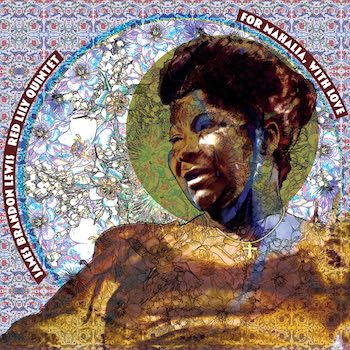Jazz Album Reviews: Kris Davis and James Brandon Lewis — Top of the Crop
By Steve Feeney
September releases from Kris Davis and James Brandon Lewis are sure to be among the best jazz albums of the year.
Kris Davis: Diatom Ribbons: Live at the Village Vanguard (Pyroclastic Records)
James Brandon Lewis/Red Lily Quintet: For Mahalia, With Love [Expanded Edition] (TAO Forms)

Cover art for Diatom Ribbons: Live at the Village Vanguard
Your list for the top ten jazz albums of 2023 has been whittled down to eight. Two near-the-top slots have already been cornered by these September releases. Kris Davis and James Brandon Lewis have done it again.
Davis has provided more than enough quality music over the years to win over any who doubt her exceptional musical talents. But the bar has been considerably raised, given her new role as Associate Program Director of Creative Development for the Institute of Jazz and Gender Studies at Boston’s Berklee College of Music. Can she live up to that position with a double-live album that fully satisfies? Yes, she can.
Following up on 2019’s highly successful album Diatom Ribbons, pianist Davis brought that recording’s core members (Terri Lyne Carrington on drums, Val Jeanty on electronics, Trevor Dunn on bass ) plus an inspired additional player (guitarist Julian Lage) into the legendary Village Vanguard in New York City in May 2022 for an extended gig that produced Kris Davis’ Diatom Ribbons: Live at the Village Vanguard.
It’s a two-disc album that aims at pulling off an impressive musical mission. Combine progressive and experimental performance strategies (including elements of conceptualism) with a traditional jazz approach that reaches over the last half century or so. From the latter end of the spectrum comes two glorious takes of Wayne Shorter’s “Dolores,” originally recorded for Miles Davis’ 1967 album Miles Smiles.
Depending on how much time you have (a thing about double albums is that they demand a serious time commitment), you can skip to those two takes, one on each disc, and sit back and forget about everything except Shorter and Davis…and Davis.
But let’s take a look at some of the album’s other riches. “Endless Columns” starts deep in avant-garde-chamber-land (among the influences cited on the album are Stockhausen, Messiaen, and Nancarrow) Electronics are prominent with the agile guitar of Julian Lage laying inside/out commentary around Dunn’s emerging electric bass pattern. This is a pattern: Lage comes on early and often to quietly commandeer this and a number of tunes on the album. Miraculously, the piece morphs into a gentle melody as Carrington sets an inviting lope on the drums. Sweetness emerges.
Another major track on the album is a three-part “Bird Suite” that stretches over parts of two sides. Jeanty adds scratches, samples, electronic bleeps, and blurps on the hard-driving “Pt 1.” Modes and metric speed bumps create a cavernous sonic netherworld. The vamp returns and Lage unites with Davis to find an ominous way out of the underground, a (pyrrhic?) journey prolonged by Dunn and Carrington.
“Pt. 2” weds actual bird calls with some crazy but insightful vocal recordings that pay tribute to Charlie Parker. Blues walks into the proceedings via unison lines coming from the piano and guitar. Except for the electronic interjections, this piece sounds like something that could have been recorded at the Vanguard decades ago. Davis and Lage demonstrate here that they know how to play it straight in front of a good rhythm section. Jeanty’s contributions on this track and elsewhere are erratic: at times it sounds like someone has wandered into the Vanguard and is fiddling with a vintage short-wave radio. Still, they often add depth and drama to the performance.
“Pt. 3″ continues down the trail of mystery and playfulness, including recorded vocal instructions from Messiaen about “the rhythm of the universe.” Collective improvisation devolves slowly into minimalist repetition that enchants.
Carrington is in full Tony Williams mode on both takes of “Dolores.” The rumbles and shuffles of her work here are exquisitely impressive.
On “Dolores – Take 2” early period John McLaughlin is evoked in Lage’s self-consciously conscious-raising guitar work. At first Davis’s piano work evokes the spirit of Herbie Hancock. But she goes miles beyond that with an intense acoustic piano solo that seems bent on deconstructing Shorter’s subtle lines in order to display their hidden complexity.
Dunn shines on “Dolores – Take 1” while Carrington again pushes and pulls. Davis ponders around a bit more on this version, focusing on the composition’s empty spaces before she fills in the blanks with a quick scamper across the keys. Lage takes a similar approach, employing his dazzling technique to tease out the contours of Shorter’s vision. This take might be the one I prefer. But it’s close.
 Along with Davis, saxophonist/bandleader/composer James Brandon Lewis has been one of the bright lights in jazz in recent years. His album Jesup Wagon, a musical tribute to George Washington Carver performed by his Red Lily Quintet, was universally declared a triumph (Arts Fuse review).
Along with Davis, saxophonist/bandleader/composer James Brandon Lewis has been one of the bright lights in jazz in recent years. His album Jesup Wagon, a musical tribute to George Washington Carver performed by his Red Lily Quintet, was universally declared a triumph (Arts Fuse review).
Now Lewis and Red Lily are back with For Mahalia, With Love, a tribute to the late, great Gospel singer Mahalia Jackson. Lewis chooses to transform songs from her repertoire that appealed to him as a child when he listened to them at his grandmother’s side.
The band remains intact and stellar. Joining the leader on tenor sax: Kirk Knuffke on cornet, William Parker on bass, Chad Taylor on drums, and Chris Hoffman on cello.
“Sparrow” begins as a sort of invocation of the gospel singer with Lewis and Knuffke playing in unison. Then comes a spirited (what would you expect?) take on “Swing Low” that has Lewis calling the flock forth with a solo intro before the rhythm section tumbles in. Parker, Hoffman, and Taylor nimbly support the horn men’s parallel improvisations on the theme. It’s a kind of grab-a-chunk approach to a great tune, one that extends its possibilities in enticing ways. Slightly obsessive but soulful, this is edgy jazz that resonances with the higher realm.
“Go Down Moses” sets up a comfortable yin-yang, with cello and cornet intertwining in expressive counterpoint. Lewis ups the tension, flooding the zone with a deluge of feisty tenor sax. “Wade in the Water” goes deep into the roots of African-American music, plowing modal routes through primal rhythms. A Parker solo plumbs the depths as Taylor proves that he knows for whom the mojo beckons.“Calvary” is a hoary incantation while “Deep River” evokes a collective understanding amid its torrent of unruly feeling.
On a bonus disc, Lewis is in front of a performance of the Witold Lutoslawski String Quartet (an exercise in aleatory music) via a compelling live recording made earlier than For Mahalia, With Love. No doubt the expert classical music reviewers at the Arts Fuse would be able to go into more detail than I can. To me, the work blends impressionism with Americana in a way that leaves room for the ambitious soloist, Lewis, to define his distinctive course. Nice bonus, indeed.
Steve Feeney is a Maine native and attended schools in Maine, New Hampshire, and Massachusetts. He has a Master of Arts degree in American and New England Studies from the University of Southern Maine. He began reviewing music on a freelance basis for the Portland Press Herald/Maine Sunday Telegram in 1995. He was later asked to also review theater and dance. Recently, he has added BroadwayWorld.com as an outlet and is pleased to now contribute to Arts Fuse.
